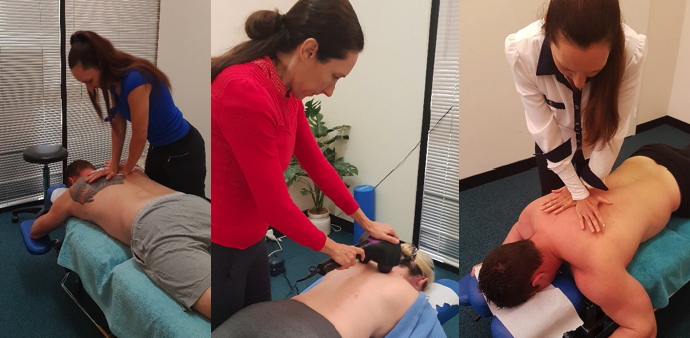
Flat back syndrome is characterised by a lack of natural curves commonly found in all spines. As a result of this, the appearance of the spine is much flatter than normal.
Common characteristics of flat back syndrome include:
- The head is protruded forward
- The shoulders are slouched forward
- Thoracic spine and lumbar spine lacks the natural curve seen in most patients
- Pelvis rotates posteriorly (backwards)
Flat back syndrome occurs when the thoracic spine is locked in extension and is generally caused by the thoracic spine attempting to position the shoulders and the head into a more upright positon. Muscles contributing to this condition consist of the spinalis thoracis, iliocostalis thoracis, longissimus thoracis and the posterior intercostals. Not having the natural curve in your back affects your body’s ability to equally distribute the load causing upper back pain to occur.
Exercises to aid flat back syndrome:
- Rolling on a massage ball over the thoracic region- Rolling on a massage ball adjacent to both sides of the spine will help free up the contracted and tender areas of the spine. Spend about 10 minutes to complete the whole thoracic region
- Flexion stretch- While seated, crunch down into a ball with your head resting on your lap and hands behind your head. Aim at feeling your upper back rolling instead of your lower back to free up the tight muscles overlying the spine. Hold for 30 seconds and take a deep breath in whilst flexing repeat 3 x
- Flexion using a foam roller- In the same position as mentioned above, place a foam roller under the chest to expand the area further and increase the stretch of the upper thoracic spine. Hold for 30 seconds and breathe in whilst maintain the position repeat 3x.
- Joint mobilisation (rotation) - In a 4 point position with your knees and hands touching the floor, lift one arm up and place it on the back of your head while twisting your thoracic spine at the same time. This will isolate the thoracic spine and stretch out the affected area. Repeat on the other side with 10 rotations on each.
- Joint mobilisation (translation)- In a seated position, stabilise your pelvis in a fixed position and translate your upper torso to either side of your body and try and lift your shoulder to the side that’s moved to further stretch that side. Repeat 15 times for the maximum effect.
- Flexion stretch with medicine ball- Bear hug a medicine ball, aiming at getting your finger tips to touch and flex your spine from the neck down. Repeat 20x.
- Intersegmental cat stretch- In a 4 point kneel position, proceed to round out your spine starting at the neck and working down your thoracic spine. For areas that’re flatter, empathise the rounding more and once finished reverse the steps and repeat them 20 x.
- Forward Bending Stretch- Ensuring you’re sitting on a flat surface, slowly reach down to grab your toes and bend from your waist. Make sure you’re not bouncing while touching your toes and bend down as far as possible. Hold the position for 20 seconds and repeat 3x.
- Lying on your back with a rope wrapped around your heel, extend one leg out to 90o and pull down on the rope. This will assist the stretch in your back and hamstrings. Exhale and hold for 2 seconds and repeat 5x. Once finished repeat on the other leg.
- In a plank position with your elbows aligned below your shoulders and arms parallel to your body, raise your hips and knees and hold for 10 seconds. Slowly release the tension by dropping down and repeat and progressively increase the amount of time planking until you reach 2 minutes.
Chiropractic Management of flat back syndrome:
Many patients with thoracic flat back syndrome can be treated without surgery and generally involve exercises to stretch and relieve tension upon the muscles that have shortened and become overactive. Physical therapy and chiropractic spinal manipulation may also be beneficial depending on the severity of the patient’s symptoms and medications in the form of NSAIDS, can also be administered to help reduce the patient’s pain.
Flat Back Syndrome is an abnormal condition that doesn’t affect many patients and can be defined as a reduction in the natural curve of the spine. Thoracic spine is the most commonly affected spinal level and can be treated by seeking a chiropractor, who can derive exercises and a management plan including spinal manipulation, to return the curve back to normal. Improving the curve helps reduce the pain by distributing the load evenly throughout the various segments involved. At Lakeside Chiropractic, we can help you in returning your natural curve back to normal and aid in reducing that back pain that has been bothering you for some time. Lakeside Chiropractic is located in Joondalup (North Perth) and has visitors from mainly northern suburbs including Jindalee, Ellenbrook, Ocean Keys, Burns Beach, Clarkson, Padbury and Beldon. We have HICAPS facilities on site to assist in the expense of your treatment and are BUPA and Medibank preferred providers, however take many others including, HIF, HBF, NIB, etc. To book an appointment you can contact us on 93000095 and speak with our receptionist or book via our ‘book now’ tab on our website www.lakesidechiropractic.com.au. We look forward to hearing from you soon and treating your condition.



